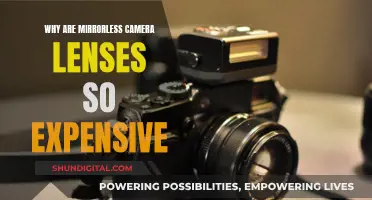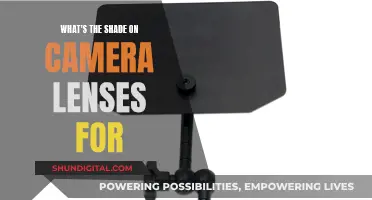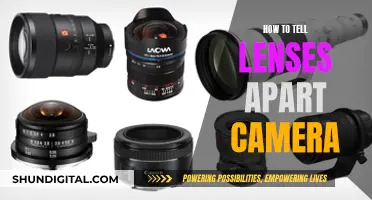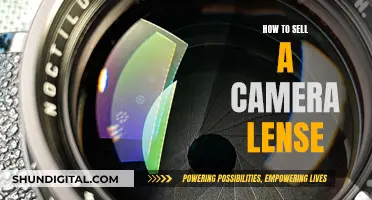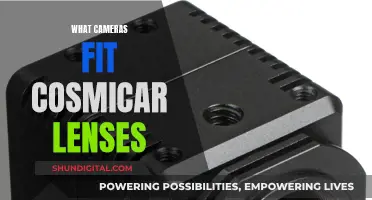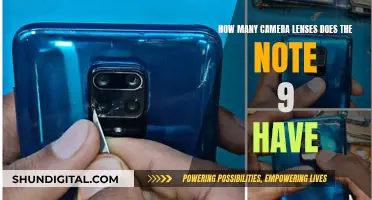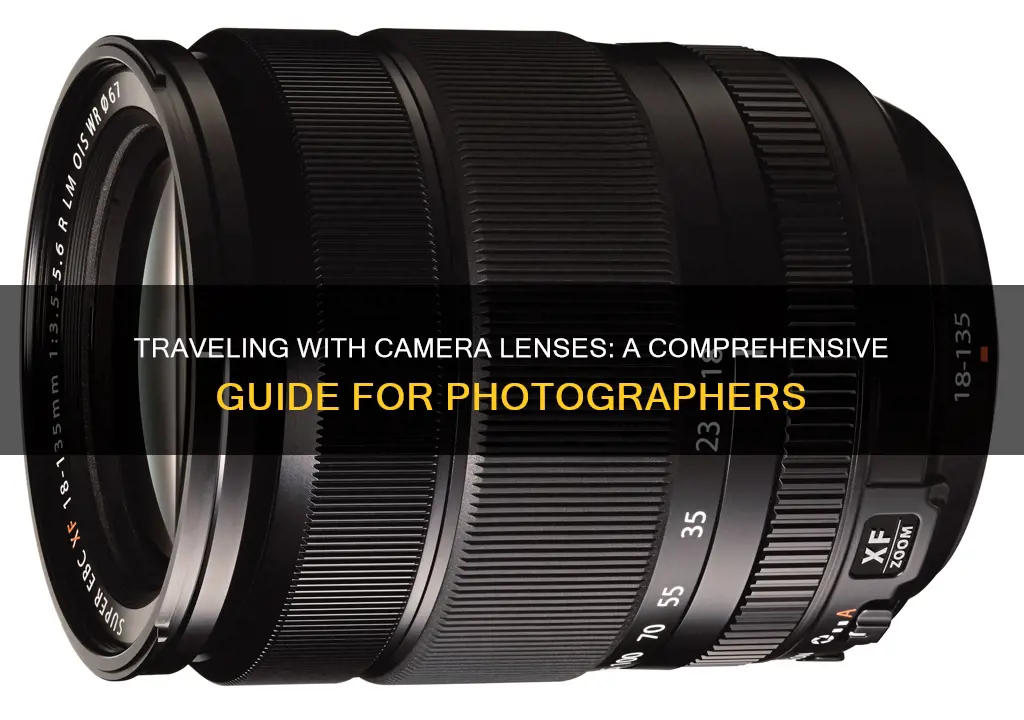
Travelling with camera equipment can be a daunting task, especially when it comes to protecting your gear from damage, theft, and the elements. Here are some essential tips to help you travel safely with your camera lenses and capture memorable photos on your next adventure.
What You'll Learn

Keep your camera close and use a neck strap
Keeping your camera close and using a neck strap is a great way to ensure your gear stays secure when travelling. Here are some tips to help you do this effectively:
Firstly, it's important to invest in a good-quality neck strap that is comfortable and secure. Avoid the stock neck strap that often comes with cameras, as these can be uncomfortable and are often branded, making your camera a target for thieves. Instead, opt for a strap from a company like Peak Design, which offers comfortable and secure options such as the Clutch hand strap or the Slide series of slings.
When attaching your neck strap, take care to do it correctly to ensure your camera doesn't come loose and get damaged. Start by threading the loose end of the strap through the camera's metal loop and the attached fastener. Then, push the upper portion of the strap through the buckle to create some slack. Finally, thread the loose end through the top inside end of the buckle and then back down through the bottom outside opening. This will create a secure double loop with no loose ends.
If you're travelling with multiple cameras, consider using a dual-carry harness system like the Money Maker from HoldFast Gear or the options available from Black Rapid. These systems will allow you to carry two cameras without the hassle of crossed straps.
When travelling, always keep your camera close to you. Use a shoulder bag or sling that allows you to keep your camera at your side, so you can always keep an eye on it. This will also make it easier to move through crowded areas without knocking into people or things.
Finally, consider the environment you'll be travelling in and take steps to protect your camera. If you're going somewhere dusty or sandy, keep your lens covered when not in use and clean it regularly. If you're travelling in humid conditions, pack silica gel packs, dry-lock bags, and water-tight bags to protect your camera from moisture damage.
Bridge Cameras: Interchangeable Lenses and Their Limitations
You may want to see also

Protect your camera from bumps, spills and theft
Travelling with camera gear can be challenging, especially when it comes to protecting your equipment from bumps, spills, and theft. Here are some detailed tips to help you safeguard your camera and lenses while on the move:
Choose the Right Bag or Case:
Consider investing in a hard-sided case with ample padding designed for camera equipment. These cases offer specialised protection for lenses and camera bodies, ensuring a snug fit and optimal defence against impacts. While such cases can be expensive, they are worth considering for the added protection they provide.
Discreet and Secure Bag:
If you prefer a more affordable option, opt for a cushioned bag or wrap your camera in protective material before placing it in your carry-on bag. You can even reuse the original packaging and box that came with your camera. When choosing a bag, look for features like padded compartments, adjustable straps, and secure closures. Ensure the bag fits your camera's size, weight, and shape, accommodating any additional lenses, batteries, or memory cards.
Protect Against Spills:
When packing your camera in a carry-on bag with liquids or toiletries, place it in a sealed plastic bag to safeguard it from any accidental leaks or spills. This simple measure can prevent damage to your camera and give you peace of mind during your travels.
Tighten Everything:
Before placing your camera in the bag, ensure all covers are securely tightened. This includes USB ports, lens caps, battery compartment panels, and any other removable parts. By doing so, you reduce the risk of parts getting torn off or broken during transit due to jostling and bumps.
Hide or Remove Branding:
Thieves often target recognisable camera brands. Consider covering or removing any camera branding, such as logos on the body and lenses, and avoid using the manufacturer's strap, which can make your camera more conspicuous. By making your camera less noticeable, you reduce the risk of attracting unwanted attention.
Insurance:
Finally, consider insuring your camera equipment before your trip. Contact your insurance company or agent for a quote. This added layer of protection ensures that you can replace your gear if it is damaged or stolen during your travels, giving you peace of mind to focus on capturing memorable photos.
Lens Compatibility: EF-S Cameras and EF Lenses
You may want to see also

Choose the right bag or case
Choosing the right bag or case for your camera gear is essential for travelling photographers. Here are some factors to consider when making your selection:
Protection
The primary function of a camera bag is to protect your equipment from bumps, spills and theft. Hard-sided cases with ample padding are ideal, as they provide the most protection. Some padding is made specifically for certain types of lenses and camera bodies, so take the time to find the best option for your gear. Keep in mind that such cases can be expensive.
Discretion
A camera bag with a discreet design can help you keep a low profile when travelling. Avoid bags that look like typical camera bags, as these can attract unwanted attention from thieves. Instead, opt for a bag that looks like a normal backpack or day bag. This way, you can keep your valuable equipment securely attached to your back or at your side, where you can always keep an eye on it.
Size and Weight
When selecting a camera bag, consider the size and weight of your gear, as well as the amount of gear you plan to carry. If you're travelling light, a smaller bag that can fit in an overhead bin or under an airline seat may be sufficient. If you need to pack more gear, look for a spacious backpack with interchangeable compartments to accommodate multiple camera bodies, lenses, spare batteries and other accessories.
Portability
In addition to size and weight, consider the portability of the bag. If you plan to do a lot of walking or hiking, a comfortable backpack with padded straps may be the best option. If you're travelling in busy cities, a shoulder bag or sling bag can be easier to carry and keep at your side, where you can always keep an eye on it.
Cost
Camera bags and cases can range from inexpensive cushioned bags to pricey hard-sided cases with custom padding. Consider your budget when making your selection, and remember that investing in a high-quality bag can provide better protection for your valuable gear.
Durability and Weather Resistance
Look for a camera bag that is durable and made of water-resistant or waterproof materials, especially if you plan to use it in harsh weather conditions. A bag with a rain cover can help keep your equipment dry in wet environments, while a waterproof bag can even allow you to take your camera underwater for unique shooting opportunities.
By considering these factors, you can choose the right bag or case to protect your camera lenses and other gear while travelling.
Point-and-Shoot Cameras: Interchangeable Lenses or Not?
You may want to see also

Keep equipment dry and avoid temperature changes
Travelling with camera equipment can be challenging, especially when it comes to protecting it from water damage and temperature changes. Here are some tips to keep your equipment dry and avoid temperature changes while on the move:
Use a Waterproof Bag or Case: Invest in a good quality camera bag or case that is waterproof or water-resistant. Look for bags with ample padding and multiple compartments to protect your gear from bumps and spills. If you're on a budget, consider using a cushioned bag or wrapping your camera in clothing, pillows, or a towel inside your suitcase.
Use Silica Gel Packs: Silica gel packs are great for absorbing moisture, especially when travelling to humid locations. Keep a handful of these packs with you, and seal your camera in a plastic bag with some of these packs when bringing it indoors to prevent condensation and moisture damage.
Avoid Extreme Temperature Changes: Try to avoid exposing your camera to drastic temperature changes, as this can cause condensation and fogging. When going from a cold to a warm environment, keep your camera in a sealed plastic bag for a while to allow the temperature to adjust gradually.
Get a Rain Cover: If you anticipate rainy weather, consider purchasing a rain cover specifically designed for your camera. This will protect your gear from light rain or drizzle and ensure you can still capture stunning photos in inclement weather.
Use a UV Filter: If your camera allows the use of filters, consider getting a UV filter. This clear piece of glass screws onto the front of your lens and protects it from scratches, salt spray, and dust. It's a cheaper option than replacing a scratched lens.
Keep Your Camera Close: Whenever possible, keep your camera with you as carry-on luggage. Avoid placing it in overhead compartments, and instead, store it under the seat in front of you to prevent jostling and potential damage.
Use a Discreet Bag: Avoid using bags that scream "camera equipment." Opt for a normal-looking backpack or day bag that doesn't attract unwanted attention from thieves.
De-brand Your Camera: Cover up any prominent branding or logos on your camera and lenses with black duct tape or matte black gaff tape. This makes your gear less desirable to potential thieves.
Use a Safe Storage Place: Whenever you're not using your camera, store it in a secure location. Use a safe in your hotel room, or leave it at the front desk for safekeeping if necessary.
Keep a Record of Your Gear: Make a list of all the equipment you're travelling with, including serial numbers, in case of loss or theft. This will also be useful for insurance purposes.
Insurance: Ensure you have adequate travel insurance that covers your camera equipment. Take pictures of your gear and record serial numbers to provide proof of ownership in case of a claim.
By following these tips, you can better protect your camera equipment from water damage and temperature changes while travelling to your favourite photo destinations.
Projector Lenses: Can They Double as Cameras?
You may want to see also

Get the right insurance
When travelling with camera lenses, it's important to get the right insurance to protect your equipment from theft, loss, or damage. Here are some tips to help you get the right insurance:
- Check your existing policies: Review your current insurance policies, such as homeowners or renters insurance, to see if they provide any coverage for your camera equipment while travelling. However, keep in mind that these policies may not cover your camera gear if it is damaged or lost during your trip.
- Purchase specialised camera insurance: Consider investing in camera equipment insurance specifically designed for travellers. This type of insurance can cover your camera gear in the event of damage, loss, or theft during your travels. It can also provide coverage for transportation, on-site shoots, and off-site storage.
- Understand coverage limits: Pay close attention to the coverage limits offered by the insurance provider. Make sure the policy covers the total value of your camera equipment, including lenses, camera bodies, and other accessories. Check if there are any restrictions on the number of items covered or the amount reimbursed per item.
- International travel considerations: If you're travelling internationally, ensure that your camera insurance policy covers your destination country. Some policies may have exclusions or limitations for certain regions. Additionally, be aware of international laws regarding lithium batteries, as most camera batteries fall under this category.
- Read the fine print: Carefully read the terms and conditions of the insurance policy before purchasing. Understand the requirements for filing a claim, such as providing proof of theft or reporting loss to the appropriate authorities. Also, look for any exclusions or limitations, such as coverage for unattended or stolen gear, humidity damage, or theft without proof of a break-in.
- Compare prices and options: Shop around and compare prices and coverage options from different insurance providers. Consider the cost of the insurance relative to the value of your camera equipment and the likelihood of needing to file a claim. Choose a policy that offers comprehensive protection at a price that fits your budget.
By following these tips, you can ensure that you have the right insurance to protect your camera lenses and other equipment during your travels. In the event of any mishaps, having the appropriate insurance coverage will provide you with peace of mind and help you avoid costly replacements or repairs.
The P30's Camera: Unlocking the Power of Multiple Lenses
You may want to see also
Frequently asked questions
It is recommended to pack camera lenses in a hard-sided case with ample padding. Alternatively, you can wrap the lenses and place them in a cushioned bag or your carry-on bag.
A good camera bag for travel should be well-padded, waterproof, and discreet. Backpacks are a popular option as they are lightweight, spacious, and suited for everyday use. The Think Tank Photo Airport Accelerator backpack, for example, adheres to international flight size restrictions.
Camera gear is allowed in both checked luggage and carry-ons. However, it is highly recommended to carry your camera lenses and other equipment onto the plane with you in your carry-on luggage. This way, you can keep a close eye on your expensive gear and avoid potential damage from checked luggage handling.
To protect your camera lenses from damage, ensure that all lens caps and other covers are tightly secured before packing. If flying, do not travel with the lens attached to the camera body, as this can damage the threads that hold the two together. Additionally, consider purchasing insurance for your camera equipment before your trip.
When travelling with camera lenses, it is important to be mindful of security and the risk of theft. Try to keep your equipment with you at all times and avoid leaving it unattended in busy areas. You may also want to remove or cover any camera branding to make your equipment less conspicuous to potential thieves.


